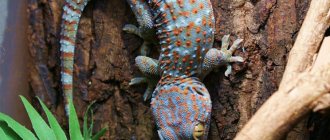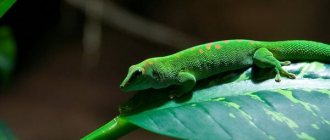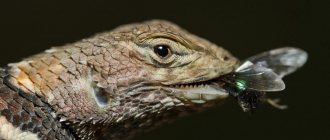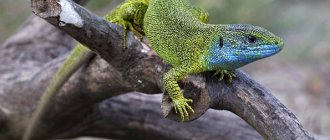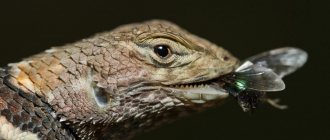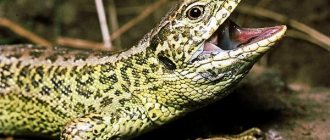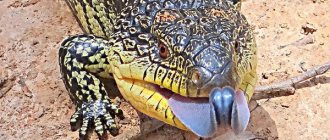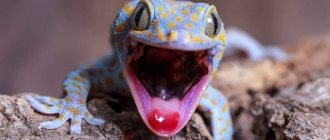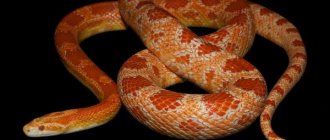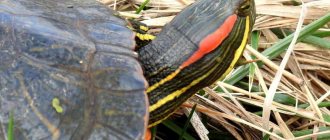Many people have pets. And if until recently only dogs, cats, parrots or hamsters were kept, now all kinds of lizards and pythons have become very popular. One such animal is the ciliated gecko (Rhacodactylus ciliatus). There are many types of geckos, they differ in size, habitat and eating habits. This reptile loves fruits, which is why it got another name: banana-eating gecko.
The ciliated gecko loves fruit, which is why it got another name: the banana-eating gecko.
Origin of the species and description
Photo: Bananaeater
Terrestrial vertebrates, labyrinthodonts, arose at the end of the Devonian period. They were still closely associated with water, but increasingly adapted to life on land. It was they who became the ancestors of reptiles - as a result of changes in the body, they became able to live at a distance from water.
As a result of the new way of life, their skeleton and muscles gradually changed, and their habitat expanded. The order of squamates arose in the Permian period from diapsids, and the suborder of lizards was formed already in the Cretaceous period. The oldest fossil remains of geckos, which include banana-eaters, date back to the same time.
Video: Banana eater
Thus, in Burma they found lizards perfectly preserved in amber that lived on Earth 99 million years ago, and some of them belong to geckos - the direct ancestors of modern species from this infraorder. One of the individuals is almost indistinguishable from a modern gecko - all the main features were formed already at that time.
The ciliated banana-eater gecko was described in 1866 by the French zoologist A. Gyucheno, the species name in Latin is Rhacodactylus ciliatus.
Interesting fact: Unlike some other lizards, when a tail is lost, the banana eater does not grow a new one. Such a loss is still not fatal, and in nature most individuals live without it, but a pet is more beautiful with a tail, and therefore you should handle them very carefully: then he will be able to keep his tail until old age.
Appearance and features
Photo: What a banana eater looks like
The size of this lizard is quite small: an adult reaches 14-18 cm, and this includes the tail, which makes up about a third of the body length. This means that the animal can fit in the palm of your hand. Its weight is also small: an adult gains up to 40-70 grams. Such small pets can live for a long time, up to 12-15 years with good care. In nature, their life expectancy is usually shorter due to threatening dangers, and is 8-10 years.
The lizard has several color variations, depending on various factors, primarily on the area surrounding the young individual: it is in adolescence that the color of its skin is established. The main options: yellow, red, brown, gray and green; the most common variations are yellow and red.
Most often, the color is almost uniform, but sometimes there are shapeless spots on the skin, for example, there are yellow-black individuals. Although these lizards are supposed to camouflage themselves with color, it is quite bright, because the nature of New Caledonia itself shines with bright colors.
Noteworthy are the growths around the eyes, for which this lizard was given its name, since they slightly resemble eyelashes. Further, two low ridges stretch from the eyes to the tail itself. The eyes themselves are large in proportion to the head, the pupils are vertical, which is why the lizard has a very characteristic “stunned” look.
The head is triangular in shape, the tongue is long, sticking it out far forward, the banana eater can catch insects. There are no ears, only holes on the head. Banana eaters are very dexterous and agile; they can easily climb both trees and glass. Such a pet looks impressive and pleases the eye.
Now you know how to keep a banana eater at home. Let's see where the lizard lives in the wild.
Where does the banana eater live?
Photo: Bananaeater in nature
This species is endemic to New Caledonia and the group of islands around it, that is, it is not found in nature in other places on Earth.
There are three separate populations of banana eaters, each with its own range:
- the first lives along the banks of the Blue River in the southern part of New Caledonia;
- the second slightly to the north, near Mount Dzumac;
- the third lives on the island of Pen, which lies southeast of New Caledonia, as well as on the small islands scattered around it.
These lizards live in trees, in the upper tier of the rain forest, that is, in a zone of high humidity and in a warm climate. The places where they live are so little touched by humans that for a long time people did not even know what animals lived there, including banana eaters.
To provide this lizard with comfort in captivity, you need to try to recreate the conditions in which it lives in nature. To do this, first of all, you will need a vertical terrarium in which you can place vines and branches so that the banana eater can climb on them, which he will do with enthusiasm.
You also need to place greenery inside the terrarium - the lizard will begin to hide in it, it really likes to camouflage itself in the grass or small bushes, and sit there in ambush. Plants can be both live and artificial. Tropical soil, coconut crumbs or other substrate is used as soil: banana eaters are not so demanding on it, the main thing is that it is moisture-absorbing.
It is necessary to maintain high temperature and humidity in the terrarium, corresponding to the rain forest. Heating is most often carried out with an incandescent lamp; at the heating point the night temperature is 26 °C, the daytime temperature is 30 °C or slightly higher. Accordingly, in the rest of the terrarium the temperature should be 3-4 degrees lower.
It is best to place a piece of driftwood under the heat source, on which the lizard can bask, and a larger one so that it can choose its own distance from the lamp. Humidity should be kept at 65%, higher at night; The terrarium needs to be sprayed twice a day, and a drinking bowl must be placed inside, although banana eaters often prefer to lick drops of water from the walls.
Keeping the Ciliated Bananaeater Gecko
12/27/2020ZooNewsExoticzooredactor
In this article you will find the basic information necessary for keeping the ciliated banana-eater gecko (Correlophus ciliatus): how to set up a terrarium for it, what conditions to create there, what to feed, how to transport it. The article was prepared by terrariumist Ekaterina Bezrodnykh based on open sources of information (books, the Internet) and her rich experience in keeping these reptiles.
Banana-eater gecko: general information
The ciliated banana-eater gecko (Correlophus ciliatus) - long considered a very rare species of gecko from the genus Rhacodactylus (changed to the genus Correlophus) is now actively spreading among breeders.
It was thought to be extinct for some time before being rediscovered in 1994.
The habitat of the banana eater is marked in red.
Habitat: eastern and central part of the island of New Caledonia. Tropical rain forests. Woody, climbing appearance. It descends to the ground only to hunt and feed on fruit litter. The period of activity occurs at night and twilight.
The average size with tail is 18-20 cm. Geckos become sexually mature quite early, often by 10-12 months. But breeding should be allowed at the age of no earlier than 15 months, with a weight of 35-45 grams. Based on this, it should be understood that when keeping young individuals together, it is worth separating the males at the age of 7-8 months.
Males and females can be easily distinguished by pronounced swellings at the base of the tail. This applies to adults. At a young age, it is not always possible to accurately determine gender. Another sign of gender is the pores in males; they appear at the age of 3-5 months (pronounced in adults).
Male
Female
The incubation period of the eggs ranges from 55 to 75 days. With good maintenance, life expectancy is 13-15 years (possibly more).
Temperature
Temperature for the ciliated banana beetle is a very important aspect that should be given special attention. A comfortable temperature is in the range of 24-27 degrees during the day; at night it can drop to 22 degrees.
They do not need a heating point; on the contrary, heating beyond the norm can lead to overheating and heat stroke. Geckos usually do not emerge from this state.
It is always worth keeping a close eye on temperature fluctuations (especially during periods when the room temperature in the house rises). In regions where the summer is particularly hot, in this case it is impossible to do without air conditioning. Just like in apartments where radiators burn out during the heating season.
If you have not yet got yourself such a pet, then it is worth checking in advance whether you can provide the correct temperature regime.
Habitat/terrarium
Vertical type terrariums are suitable for keeping ciliated banana eaters. It is very good if the height is at least 60 cm.
The minimum size per individual is considered to be 30x30x40 (bigger is better). A group of three adults will be more comfortable in a terrarium measuring 40x40x60. For children and teenagers, use smaller houses so that the gecko can easily find food. And you were able to find him. Flow ventilation is required. There must be good air inflow and outflow.
As described earlier, banana eaters are an arboreal species, so the terrarium should have a lot of snags and vines, and the bark of the cork tree has shown itself to be very good for furnishings and decoration (light, washes well, does not rot).
An example of arranging a terrarium
If you want to decorate your terrarium with living plants, then they should be non-poisonous, moisture-loving, with strong leaves.
For shelter, ciliated banana eaters like to use bark, hollows, wide and dense vegetation, as well as coconuts (hanging houses make an excellent shelter).
The terrarium for the ciliated banana beetle can be made of either glass or plastic. Now there is a large selection of plastic containers of different sizes that can be equipped according to all the rules, provided with ventilation and turned into an excellent terrarium.
An example of arranging plastic containers
Humidity
Air humidity should be 60-75%. Achieved by spraying the terrarium (several times during the day). Geckos happily drink from the leaves and walls of the terrarium. It is worth monitoring the purity and quality of the water. You can spray manually or install an automatic precipitation system. It has been observed that geckos tolerate temporary decreases in humidity without problems.
Lighting and UV
If you wish, daylight hours can be observed; it is 12-13 hours. It is important that the lamp does not heat the terrarium; this was discussed in more detail earlier in the paragraph on thermal conditions. (LED lamps heat up the least). The need to use ultraviolet lamps causes a lot of controversy among breeders. Drawing a generalized conclusion from the knowledge gained, we can say that a low-power UV 5.0 lamp (UVB 100) in a terrarium will not hurt. You can also do without using it, provided that the gecko receives good calcium with vitamin D3 in the composition.
Priming
Geckos spend most of their lives above ground, so there is no strictly suitable option (it all depends on your choice).
The most practical options are special reptile mats/artificial turf. My personal experience has shown that this is the ideal option. Pros: easy to clean (in the bathroom, with a brush under running water and laundry soap - shake off excess water and return to the terrarium); midges and nematodes do not appear; When hunting, geckos do not get any excess food into their mouths. Also often used as soil are: coconut substrate, coconut shavings, high-moor peat (also a mixture of them), sphagnum moss. The advantages of natural soil: planting plants (but do not forget that plants can also be planted in pots); an additional source of humidity (if the air in the house is very dry, they help out); look beautiful in biotope terrariums.
For those who chose natural soil: do not forget to moisten it well, but moderately, and lay it tightly (so that the banana eater does not “slip” on it). And be sure to monitor your diet to see if a large amount of soil gets into the digestive tract.
Feeding
The species is 45% insectivorous and 55% herbivorous. Insects predominate in the diet of children and adolescents. So, in the period from birth to 3 weeks of age, I feed the babies mainly insects (crickets), then I begin to introduce fruit purees/ready-made diets into the diet. Adults need to be fed three times a week. Teenagers - every other day. The kids eat every day (if you have eaten a lot, you can skip it). Feeding should be done in the evening or early in the morning (taking into account natural biorhythms). If you leave food for self-feeding, this should be done at night.
Feeding banana eaters can be divided into three types: - completely natural. These are insects (crickets, cockroaches, locusts) and fruit puree that you prepare yourself.
Bananaeater hunts Suitable fruits: peaches, apricots, mangoes, pears, sweet apples (not many), banana, etc. Ripe or overripe fruits are included in the diet.
Ready-made purees for baby food from the above fruits are also suitable. (We carefully study the composition: only fruit, without added sugar, citric acid and cottage cheese). And good calcium and vitamins are added to this diet. Use according to instructions. Insects are pollinated in them or mixed into fruit purees.
On forums and public pages where banana eater breeders communicate, you can find recipes for making natural purees with a variety of compositions. — ready-made diets (they are complete diets).
There are a wide variety of flavors and formulations of ready-made gecko diets on the market.
The most famous manufacturing companies: Pangea, Repashy, Zoo Med, Lugarti. Aromatic dry mixtures for making 3in1 purees, combining protein (insects) and fruit. They also contain calcium and vitamins.
Such diets can completely replace natural feeding. As the saying goes, “just add water.” Many keepers still add a little extra calcium to the diet when feeding this way. - mixed. As you might guess, this type of feeding combines the first two (the one I have chosen at the moment).
My geckos' adult diet is based on Pangea ready-made diets. About once a week I release live crickets pollinated in calcium (zoo med with D3). Geckos enjoy hunting. Sometimes I offer purees for baby food. (Most people liked the “Fruto Nanny” brand - fruit salad and pear).
I give vitamins extremely rarely because... They are present in Pangea. About once a month, for growing geckos and laying females. I mix a small amount of calcium into the puree (not often). Calcium with vitamin D3 as a part. I don't use UV at the moment.
ps I recently learned about a new option for feeding purees (Pangea or regular fruit) + Repashy Grub Pie. In this version, a little grapaya is mixed into the puree and fed to the geckos. As the practice of colleagues has shown, it is quite successful. More often, this feeding is used for babies who refuse insects.
Water
Although geckos drink water while spraying from the leaves and walls of the terrarium, a bowl of water is still a mandatory attribute. It can be conveniently mounted on a snag or wall.
The ideal option is to purchase a ready-made set of bowls for water and puree with fasteners. It is worth changing the water as often as possible (ideally once a day). And always keep it clean.
Shedding
The process of changing old skin to new takes place regularly.
Young individuals molt more often, adults - less often (approximately once a month). During the molting process, in most cases the gecko eats it completely. This is a very interesting and entertaining process. Occasionally you can notice pieces of moult remaining in the terrarium.
Before molting, you may sometimes notice that your gecko has become less active. It does not cling well with its paws and can spend time in a shelter or at the bottom of the terrarium. There's no need to worry. Healthy animals that are kept in good conditions, with proper nutrition and proper humidity, rarely experience problems with shedding.
The molt is very thin and can tear; the gecko will remove it on its own
But you still need to inspect, and if you notice remnants of fresh shedding, it can be easily removed by moistening a cotton swab or cotton pad with water. Lightly soak the area where the molt remains if it has already dried. Gently remove it with gentle movements. But if there are still lesions on the skin, you can lubricate the area with Bepanthen/Dexpanthenol ointment 5%
Vitamin and mineral supplements
They are selected and calculated individually, based on the diet and the presence of UV in the gecko’s terrarium. I also leave here a list of companies that have proven themselves well: Zoo Med, Repashy, Fluker's, Food Farm.
“On” or “off”. About the ability of the banana eater to change color
As many already know, ciliated banana beetles not only bloom from birth to sexual maturity, but can also change color within a day. It becomes as bright, contrasting, colored as possible “light up” and be almost imperceptible, pale “do not burn”.
An example of two color variations at once (under the paw is a piece of “uncaught” leather)
These conditions are influenced by many factors: humidity, temperature, stress, aggression, lighting, activity of the gecko itself, etc.
Of course, the maximum delight is caused by the geckos that “lit up” in full force. Bananaeaters can display both the entire color and its components separately from each other: for example, the main color background of the gecko may not light up, but stripes and spots light up, or the bananaeater lights up “in parts” - as shown in the photo.
Relocation/Interaction
Banana eaters cope with moving differently and also adapt at different speeds; this is influenced by many factors (we try to reduce the stress of moving to a minimum). It is IMPORTANT to observe temperature and humidity conditions during transportation. Below are recommendations on what to do after the gecko arrives to you (everything should be equipped IN ADVANCE - this is the most important thing):
— upon the pet’s arrival, immediately moisten/spray the terrarium generously (this way the banana-eater can immediately drink and restore water balance faster);
- leave him completely alone for a day (he must master his territory and feel safe), it is better not to turn on the lighting;
— it is highly not recommended to place a newbie with already living geckos (it is necessary to endure quarantine and introduction/sharing should occur gradually). Also your acquaintance/interaction with him;
— food can be left on the first night after arrival (many people willingly eat right away). Be sure to ensure that your new pet begins to eat.
It is better to contact in the evening or early in the morning (based on the gecko’s biorhythms), or if you see that it is active at that time. (Geckos are not “squeeze” geckos; they are suitable for children only for contemplation in a terrarium).
Here you need to understand that the gecko should not be held in your arms for a long time (for reasons such as not to overheat). And also so as not to cause him unnecessary stress. Short contacts are tolerated quite well. If the banana-eater is nervous and tries to run away, you should immediately release it back into the terraimum and leave it completely alone. The further behavior of the gecko is influenced by its character and environment. Over time, you will begin to better understand your pet's needs and personality. And if you do everything right, it will delight you for many years!
Tail
The banana eater's tail is very tenacious and helps it hold on to various objects such as branches and vines.
A gecko may lose/drop its tail when frightened or under extreme stress and when it feels threatened. It is necessary to close the doors/lid of the terrarium carefully so as not to get the tail pinched. Banana eaters love to slip them in at the most inopportune moments. The banana eater is not able to regrow its tail. Losing a tail does not affect quality of life in any way. And it is only a cosmetic “flaw”.
Ekaterina Bezrodnykh
Group of Ekaterina Bezrodnykh VKontakte - EXOTVER
What does a banana eater eat?
Photo: Ciliated banana eater
In nature, this lizard is omnivorous; its diet includes both plant and animal foods, usually the ratio is close to equal, with a slight preponderance of plant foods. It is advisable to maintain the same ratio when keeping this animal in the house, but it is worth remembering that its jaw does not allow it to eat large pieces, and its teeth are poorly suited for biting off.
The following livestock can be given to banana eaters:
- crickets – two-spotted and banana;
- Zophobasa;
- mealworm;
- caterpillars;
- cockroaches;
- grasshoppers.
These insects must enter the terrarium alive, then the lizard's hunting instinct will awaken, and the best time for hunting comes at sunset. But you should select small prey, it should not be larger than the distance between the eyes of the banana eater, so that it can swallow the prey.
Feeding with insects is usually carried out once a week; an adult lizard needs to be fed plant food twice more. The easiest way is to give her artificial food: it contains all the necessary vitamins, so you don’t have to worry about balance. But instead, you can feed her fruit.
It can be:
- bananas;
- apricots;
- peaches;
- papaya;
- mango.
It is important to give not just one fruit, but several different ones, and not whole, but in the form of puree. You cannot feed the banana eater citrus fruits. Multivitamins and calcium should be added to the puree. Young lizards need a slightly different approach: they are fed more often, usually once every two days, and at first even every day. After they begin to feed on insects, during the period of rapid growth they should be given mainly to them - a growing banana eater requires protein food.
Interesting fact: You can keep several banana eaters in a terrarium, but there should be only one male in it, otherwise there will be fights for territory.
Conditions of detention
Banana eaters need a vertical terrarium with a background and plenty of branches for climbing and hiding places. The size of the terrarium for one adult gecko is from 30x30x45, for a group - from 45x45x60. Babies can be kept in smaller volumes or in suitable containers.
Temperature: background daytime 24-27 °C (room), at the warming up point - 30-32 °C. Background night temperature is 21-24 °C. Background temperatures above 28°C can cause stress, dehydration and possibly even death. Heating is preferable with a lamp (with a protective grid). There should be good branches at different levels under the warming point so that the gecko can choose the best place.
Ultraviolet: In the literature they write that ultraviolet is not necessary, but I personally encountered convulsions in geckos that went away after installing a UV lamp. Quite weak (ReptiGlo 5.0 will do), because... Animals are nocturnal after all.
Humidity: from 50%. Spray the terrarium in the morning and evening, spray the soil well to maintain the humidity level (a spray bottle with a pump will be convenient for these purposes) or purchase some kind of device for maintaining humidity.
Kit for ciliated banana beetle “Standard”
Soil: Coconut shavings (not peat), sphagnum, gravel. Regular napkins are also suitable (geckos do not go to the bottom very often, preferring branches), but provided that they are changed frequently, because... Due to the humidity, they quickly turn into something unkempt. If you have a breeding group of geckos, the soil must be examined for the presence of eggs; females like to hide them in secluded corners, and even a special wet chamber does not always keep them from doing this.
Features of character and lifestyle
Photo: Banana-eating gecko
In nature, banana eaters become active at dusk and hunt all night long, resting during the day. They have a similar way of life in captivity, although it may undergo slight changes: many owners of these lizards note that over time they begin an active life early in the evening, and by the end of the night they are already sleeping.
But still, in order to observe such a pet, it is advisable to have night lighting in the terrarium, preferably dim and simulating moonlight, so as not to disturb it. It is also worth choosing the lighting so that it does not increase the temperature in the terrarium, otherwise it will be more difficult to control, and every degree is important.
At first, the banana eater may seem very lazy and slow; it can simply remain on a snag almost motionless for many hours. But such an impression is deceptive, and if you open the terrarium, you can quickly verify this: the lizard will probably immediately try to sneak out of it. She runs away so quickly and deftly that without preparing in advance, it will be impossible to catch her. And even with preparation, the escape can still be successful: the skill of catching it is developed only through training. The banana eater can also hide, so finding it later in the apartment will also be difficult.
He also demonstrates agility when hunting. First, it usually takes a closer look at the prey - it can spend up to half an hour after it is released into the terrarium. After choosing the right moment, it makes a rush so fast that its beginning is difficult to notice, and quickly swallows the prey. Then the hunt is repeated, and this can continue from the evening of feeding until the morning.
They differ in character, but in the majority they begin to behave calmly with people after they get used to the new place and stop trying to escape. You can feed them fruit puree directly from your hands, in the evenings and at night you can let them out of the terrarium and play; at other times it is not recommended to do this, and they themselves are lethargic.
It is not difficult to care for this lizard, it has a friendly character (there are exceptions, but they are quite rare), and it may be suitable for those who:
- likes to keep reptiles in the house;
- ready for the fact that the pet will not feel any affection for him;
- does not want to give the pet a lot of attention;
- prefers to watch the animal rather than petting or holding it;
- I am ready to provide him with a good terrarium - he cannot be kept in cramped and inappropriate conditions.
If you have children, it is not advisable to have a banana eater, or at least it is worth limiting contacts between them, since these lizards are small and very vulnerable: even if the child does not want to cause harm, it is enough to simply squeeze a little harder or carelessly grab it to cripple it.
Shedding period
Molting processes in banana-eating geckos occur regularly (every 30-35 days). During this period, your lizard may seem less active, and will be characterized by lethargy and loss of strength. The skin will take on a dull gray tint and then peel off. It may happen that the gecko eats it, but there is no danger to his health.
Important! Purchase a special hygrometer for the terrarium, which will help you most reliably measure air humidity.
During the molting period, it remains important that the owner of the reptile needs to maintain high air humidity in the terrarium (at least 70%). If this rule is not followed, the lizard may not shed all its skin; pieces will remain near the eyes and between the fingers.
In the future, this can lead to the death of the tail and toes. To prevent this, you need to place your pet in warm water (about +28°C) for half an hour, and then use tweezers to remove dead areas of the epidermis.
Social structure and reproduction
Photo: Banana-eating lizard
Males reach sexual maturity by a year and a half, females six months later. But it is better to wait some more time before you start breeding lizards. Males and females are distinguished by their genital bursa - only the former have it. In nature, the breeding season of these lizards begins annually with the arrival of spring and continues until summer. In captivity, you can adhere to the same terms, but it is not necessary. For breeding, a female or several are placed with the male, and after mating occurs, they should be placed again.
The fact is that males show aggression at this time; the female often has bite marks on her neck, and if they are not separated in time, the male can bite off her tail. The female should be placed in a terrarium with a thick layer of soil - she will bury eggs in it after 30-40 days of pregnancy. There are most often one or two eggs, the temperature inside the terrarium will need to be maintained at around 27 °C, and they develop within 50-80 days. During this time, they can be left in the terrarium, but it is better to place them in an incubator.
If the eggs do not harden, it means there is a lack of calcium in the female’s body. In this case, you should add more of this element to her diet and try again no earlier than after 4 months, when the problem has already been definitely solved. Only hatched banana eaters weigh only a few grams; at first they need to be given small larvae and insects, and by the fifth day you can add some plant food. The temperature in the terrarium should be high, but young lizards should not be overheated, otherwise they will grow weak - 28°C will be enough.
How to determine the sex of a banana eater?
In order to form a pair, you need to know what females look like and what males look like. Determining the sex of adult ciliated banana eaters is very simple: males are distinguished by a characteristic swelling-pocket at the base of the tail with hemipenes. Females do not have them.
male banana eater
female banana eater
In young geckos, before clear sexual dimorphism appears, sex can be determined by the presence or absence of preanal pores. In females there are no such pores, but in males their clear rows can be seen. Usually they are clearly visible around six to five months; you can see them earlier using a magnifying glass (40x magnification).
In males, the scales at the base of the tail are “overlapping”, slightly overlapping each other, like in a fish. May appear glossy. The scales of females are close to each other and do not stand out from the general background.
Pores in a male.
male
female
Natural enemies of banana eaters
Photo: What a banana eater looks like
The ciliated banana-eater gecko is a small lizard and almost defenseless against animals larger than itself, so the danger to it comes from almost all such predators. To a much lesser extent, it is threatened by those of them that are not able to climb trees, since the banana eater spends most of its time on them, and can escape there.
Such enemies include, for example, snakes - most of them cannot hunt lizards in trees. Birds of prey like the Australian brown hawk are much more dangerous. The banana eater's only chance is to hide from them in dense thickets; there are no other options to escape from the formidable claws and beak.
Their habitat itself helps these lizards survive: dense rain forests are not very convenient for birds to look for victims, their miniature size and color make banana-eaters unnoticeable, and their speed and agility give them a chance to escape even if a predator does notice.
Interesting fact: Once every 3-4 weeks, the lizard molts. At this time, she becomes lethargic, and her skin becomes dull. For molting to go well, it is imperative to increase the humidity to 70-80%, otherwise pieces of old skin may remain on the pet after it is completed, and over time this sometimes leads to problems with the fingers.
Experienced lizard owners can and are guaranteed to avoid trouble: to do this, they place the lizard, ready to molt, in a warm liquid for half an hour, and then remove the old skin from it with tweezers. After the process is complete, she sometimes eats the skin.
Lizard Handling
Like many lizards, the banana gecko can drop its tail to escape a predator. Therefore, you need to be very careful when handling it so as not to damage the tail. The eyelash lizard does not grow a tail. This reptile is timid; when purchasing and moving to a new home, it is better to leave the lizard alone for a while and not pick it up. Give time for the pet to get comfortable in its home.
After this, you can pick it up, but the first time is not long, a few minutes. Each time you can increase the time.
